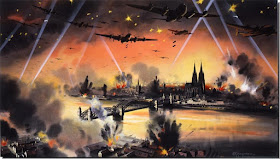 |
| Painting depicting a British convoy on way to the Russian port pf Murmansk with arms for the Red Army. ("Convoy of British merchant ships" by Blake, Post-1941) |
 |
| British coastal artillery on the Dover coast firing away. "British coastal artillery" by Terence Cuneo, Pre-1944 |
 |
| A British anti-tank gun in the desert of Libya.. "British anti tank gun" by Harold Pym, 1943 |
 |
| A British Matilda tank in Libya. "British Matilda tanks" Artist unknown, Post-1942 |
 |
| British soldiers from the Parachute regiment come out from gliders and engage the Germans in fighting.. "Parachute Regiment" by Leslie Oliphant, Date unknown |
 |
| A British general with binoculars as Sherman tanks trundle and fighter planes fly over the skies.
"A British General, holding binoculars" Artist unknown, Date unknown |
 |
| Daylight raid by Lancaster bombers on the Schneider armaments factory in Le Creusot (France), carried out on 17 October 1942. "Daylight raid by Lancaster bombers" by O'Connell, Post October-1942 |
 |
| "Japanese flying boats being destroyed" by Roy Nockolds, Date unknown |
 |
| Bristol Blenheims conducting a daylight raid on the German power stations at Knapsack and Quadrath near Cologne, 12 August 1941.. "Bristol Blenheims" by James Gardner, 1941 |
 |
| Bombing of Cologne. "Night bombing raid on Cologne" by W.Krogman, Date unknown |
 |
| A British bomber under attack by a German plane. "British Manchester bomber defends itself" by W.Krogman, 1939-1945 |
 |
| A British Sterling bomber attacks a German industrial target. "British Stirling heavy bombers" by W. Krogman, 1941 |
 |
| A German Stuka and a Heinkel shot down by British warplanes. "Battle of Britain" by Oliphant, Leslie, 1940 |
 |
| A British fighter pilot. "British fighter pilot" by F.Matania, Date unknown |
 |
| A British Hurricane fighter attacking a Japanese troop convoy in jungle country (possibly Burma). "Japanese troop convoy" by Roy Nockolds, Post-1941 |
RELATED




